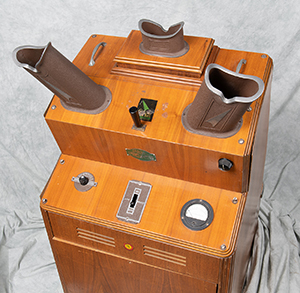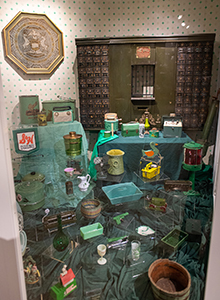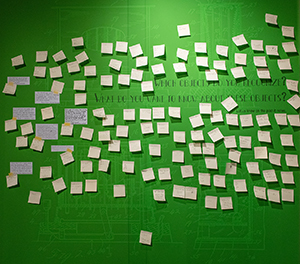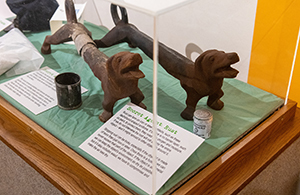The stuff that tells stories
By SUZANNE FISCHER
Michigan Department of Natural Resources

What does your stuff say about you? What does Michigan's stuff say about Michigan?
The lamp on your nightstand, the footstool in your living room, the coffeemaker in your kitchen – they all have stories to tell about you and your family. Put your stories together with those of people all over the state, and you get Michigan history, being made every day.
The Department of Natural Resources preserves and shares Michigan’s natural and cultural heritage – but did you know that includes a hair wreath, an Atari game system and many elaborate toasters? The Michigan History Center, part of the DNR, uses objects to tell stories about our state. The center collects, preserves and shares over 100,000 Michigan-related objects, cares for them on behalf of residents and ensures that the state’s important historical artifacts are stored safely to protect them for the future.
“We have some really fun, interesting and weird artifacts that we would have no reason to ever put on display,” said Rachel Clark, Michigan History Center education specialist. “When I saw the foot X-ray machine that was used in shoe stores in the mid-20th century, I thought, ‘We need to create an exhibit that shows this and other fascinating artifacts in our collection.’”
A team made up of staff members from all areas of the center spent nearly a year combing through the collections and developing an exhibit that does just that.
|

In June, a new exhibit called “Secret Lives of Michigan Objects” opened at the Michigan History Museum in Lansing. It explores how Michigan’s stuff tells Michigan’s stories, the way your own stuff tells your story. Broken into multiple smaller sections, the exhibit invites museum visitors to explore what it means to collect and care for objects.
The first artifact visitors encounter sits alone in a case in a dark space. It is dramatically lit. The mood is hushed. It’s … a Vernor’s bottle?
This playful exhibit upends ideas about how museums collect and display objects and why. A mass-manufactured object deserves the Hope Diamond treatment because it can tell a lot of important Michigan stories.
Another section features 75 objects from the museum’s collections, all with one thing in common: they’re green.
“History museums usually organize their objects chronologically, geographically, or by their stories,” said Meagan Papineau, the exhibit’s designer. “We wanted to see what questions and feedback we could generate by putting a lot of green things together.”
|

Museum visitors are asked to share on Post-it notes what they’d like to learn about the display. Museum staffers are finding the answers and responding to the questions in the gallery.
One visitor asked who the green clothes had belonged to, and one of the museum’s exhibit designers responded with the story of a dress she made during the 1960s.
The exhibit will grow and change during its run based on input from museum visitors and on the Michigan History Center’s social media channels.
“Between now and September, we have a lot of questions we want to ask people about the exhibit,” said Sara Gross, the center’s engagement specialist, who designed the social media aspects of the exhibit. “We have created a special hashtag, #ThisBelongsInMyMuseum, and are asking visitors to post their favorite personal objects and stories on Facebook, Instagram and Pinterest. We also need help choosing what artifacts get added to the exhibit.”
|

For example, visitors can vote in the gallery and online for which of the museum’s most unusual objects will go on display this fall. Options include a wreath made for a teacher from the hair of his students; a very decorative, if not slightly impractical, toaster; and an umbrella with a compass in the handle that, as the story goes, was given by Abraham Lincoln to a Union nurse who had gotten lost and captured during the Civil War.
A central feature of the exhibit is a re-created 1970s basement. That is, a partially re-created basement – while the orange shag carpet and furniture are in place, details like wall hangings and personal objects are still missing. Visitors are encouraged to suggest artifacts they think convey a more complete picture of life in Michigan in the 1970s.
|

The exhibit also offers a behind-the-scenes look at how museums choose what to collect and how they take care of the artifacts they do collect. An empty case symbolizes all the stories of Michigan’s diverse people that the Michigan History Center has not yet collected. A special section shows the different ways objects deteriorate over time, and how museums work to slow down these changes.
Lastly, the exhibit invites visitors to bring in their own artifacts to become part of the exhibit, only for a few minutes. A special case that is missing one side has been set up. Visitors can place their own objects in the case, add a label and take a picture.
Everyone’s objects – including the ones that say something about our lives in 2019 – belong in a museum.
“Secret Lives of Michigan Objects” runs through June 2020. The exhibit is included with Michigan History Museum admission.
Museum visitor information is available at Michigan.gov/Museum.
|
Check out previous Showcasing the DNR stories in our archive at Michigan.gov/DNRStories. To subscribe to upcoming Showcasing articles, sign up for free email delivery at Michigan.gov/DNR.
/Note to editors: Contact: John Pepin, Showcasing the DNR series editor, 906-226-1352. Accompanying photos and a text-only version of this story are available below for download. Caption information follows. Credit Michigan Department of Natural Resources, unless otherwise noted.
Text-only version of this story
Bottle: The first artifact visitors encounter in “Secret Lives of Michigan Objects,” this Vernor’s bottle is part of the exhibit’s playful look at how and why museums collect and display objects.
Green 1 and Green 2: One section of the exhibit features 75 green objects from the Michigan History Museum’s collections.
Notes: Visitors are asked to share on Post-it notes what they’d like to learn about one of the exhibit’s displays. Museum staffers are finding the answers and posting responses in the gallery.
Room: A central feature of the exhibit is a partially re-created 1970s basement, where visitors can suggest artifacts to complete the picture of Michigan life in the era.
Rust: A special section of the exhibit looks at ways that objects – like these rusty, dachshund-shaped andirons – deteriorate over time, and how museums slow down these changes.
Umbrella: Among the objects up for vote to go on display in the fall is this umbrella with a compass in the handle that Abraham Lincoln gave to a Union nurse who had gotten lost and captured during the Civil War.
Voting: Visitors can vote in the gallery and online for which of the museum’s most unusual objects will go on display this fall.
X-ray: This foot X-ray machine, used in shoe stores in the mid-20th century, is one of the fascinating artifacts in the Michigan History Center’s collection that inspired this exhibit./
|